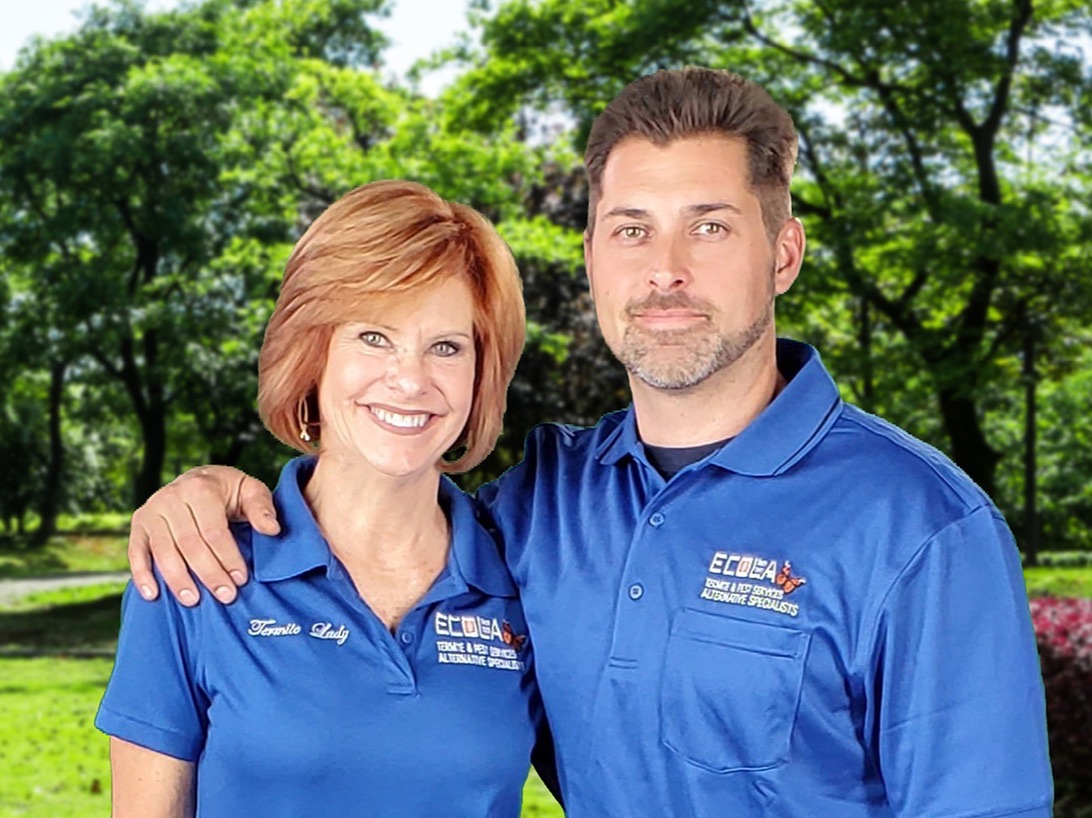TO SAN LUIS OBISPO

Termite Control
Are you wondering how long you can wait to get your termite service?
The longer you wait the more damage is done!
Below you’ll find answers to common termite control questions. If you’d rather speak with an Ecola expert, we’re happy to answer your questions, offer basic guidance and even send a technician to your home for a free inspection.
What do termites look like?
Termites look similar to flying ants, except they have elongated bodies rather than separated body parts. Termites have a straight waist and antennae, plus two pairs of wings that are equal in size.
In Southern California, we deal mostly with two types of termites: Subterranean and Drywood. Subterranean termites live within the ground and travel to your home structure in mud tunnels. Drywood termites live in the wood and produce small round pellets that resemble coffee grounds.
Prefer video responses?
Watch Sue and Tyson answer common questions on termites:
- Are Termites a Problem You Can Ignore?
- Different Termite Species Require Different Solutions
- How to Tell Termites Apart
- What Are Termite Swarmers?
- Subterranean Termites: What You Need to Know
- 4 Tips to Keep Termites Out
- How to Fight Termites and Save Money
- Electro Gun: The No-Chemical Termite Solution
How do I know I have termites?
- The most obvious sign of termites is a cloud of insects swarming in a big flying formation. Pay attention to where they’re flying: Drywood termites generally swarm in the morning and fly toward sunlight. They’re searching for mates to start new colonies!
- Look for discarded wings. Swarmers shed their four wings after mating.
- Watch for mud tunnels (the size of a pencil or so) from the ground to your home. They might appear on drywall or along floors.
- Termites also leave behind droppings that look like salt and pepper or multicolored coffee grounds. Look for these near wood trims, doorways, inside or outside windows, the sides of your garage doors, or any exterior wall.
- Also check subterranean areas and attics for signs of termites.
If you spot any of these signs, call a trusted professional to treat your property right away. Quick action is critical to limit damage.
What kind of damage can termites do to my home?
Left alone, termites can chow down on wood and other cellulose-based materials like books, tree roots, furniture, and more. The damage can even compromise your home structure.
Termite damage usually isn’t covered by your homeowners’ insurance, so an infestation can also eat through your finances. If there’s structural damage to your home, you could be looking at thousands of dollars in damage. One of our customers spent tens of thousands of dollars to have the second story of his home raised to replace damaged wood on the first story. That’s a worst-case scenario, but any damage scenario isn’t something you want to face.
Bottom line: Avoid costly damage by engaging professional help as soon as you suspect termites.

How can I prevent termites?
Drywood termites enter your home by finding damaged or unfinished wood, then burrowing a hole into it and starting a colony. Replacing previously damaged wood and applying two coats of quality paint to all wood surfaces is an excellent preventive measure. Sealing and caulking the cut ends of fascia (trim boards) also helps prevent the entry of drywood termites.
What are some treatment methods for termites?
Different termite species require different solutions. To determine the right treatment, we’ll need to know what type of termites you’re dealing with.
Fumigation is one option to get rid of termites. Eco-friendly, non-chemical alternatives include heat or electricity treatments. In many cases, the Electro Gun is an effective treatment that uses no harmful chemicals. Instead, it uses high-frequency, high-voltage electricity to penetrate wood and flow into termite galleries and nests, killing them.
Since the Electro Gun uses no chemicals, you don’t have to move out of your home or remove items like food, plants and clothing during treatment. Plus, there’s no residual damage to animals, humans, plants or aspects of your home like your roof.

We’re in your neighborhood!
With multiple locations and decades of service, chances are we’ve served some of your neighbors! Below are locations we service:
How much is termite treatment?
Expenses relating to termite control fall into three categories: prevention, eradication, and damage to your home. The national average costs for eradicating termites in a 2,500 sq.ft. house run from about $800 for bait treatments, $1,500 for liquid treatments, $2,500 for heat treatments, and up to $3,000 for fumigation.
Depending on the extent of the infestation, repair might require opening walls and flooring to replace damaged home foundations, furniture, or other affected items. The national average expense for a homeowner who discovers termite damage is $3,000.
It pays to act quickly: When infestations are caught early, the damage is localized and much less severe. We invite you to take advantage of Ecola’s free pest control inspections to help you discern what you’re dealing with and how to move forward.
(Psst: Check our Specials Offers page for current promotions!)
Educate yourself on the type of bugs you can find in
and around your home.